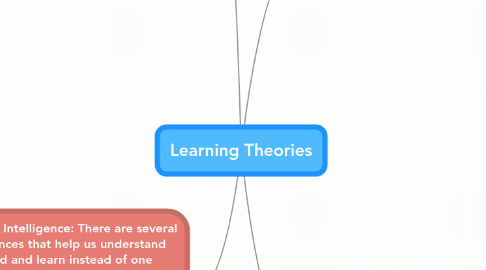
1. Multiple Intelligence: There are several intelligences that help us understand the world and learn instead of one intelligence (Gardner)
1.1. Intelligences
1.1.1. Correspond to traditional understanding
1.1.1.1. Logical-mathematical
1.1.1.2. Linguistic
1.1.1.3. Spacial
1.1.2. Innovative but controversial (does it apply for all fields and is it only an area of talent development)
1.1.2.1. Bodily-kinesthetic
1.1.2.2. Musical
1.1.2.3. Intrapersonal
1.1.2.4. Naturalist
1.1.2.5. Interpersonal
1.2. Instructional Application
1.2.1. Design instruction to recognize learners' abilities and preferences
1.2.2. There are multiple ways to teach and learn: use a variety of activities (Use learning contracts to carry out activities)
1.2.3. Presentations, simulations, role playing, debating, simulation software for teaching writing
1.2.4. Use instructional strategies that could strengthen all intelligences for all students
1.2.5. Work centers
1.3. Benefit
1.3.1. Learn to incorporate different intelligences into traditional learning
1.3.2. Students' needs, interests and talents are met
1.3.3. Possible increase of parent and community involvement
1.3.4. Students can demonstrate their strength and accumulate positive educational experiences
1.4. Criticism
1.4.1. The intelligences are not well defined
1.4.2. The strengths and weaknesses of one's intelligences are very culturally defined
1.4.3. The theories might be utopian and might not necessarily be practical to compare and increase students' skills across classroom
1.5. What multiple intelligence doesn't imply
1.5.1. Being low in one intelligence implies being high in another
1.5.2. A law of fairness: every child is smart in his/her own way
1.5.3. Identify child's particular intelligence and teach by "how you're smart"
1.5.4. Learning outcome will improve if instruction directs to certain learner types
2. Cognitive Theory: Internal biological development affect cognition and learning (Piaget)
2.1. What it is
2.1.1. Cognitive development is dependent on the right condition at the right time, and mismatch between prior knowledge and current experience creates learning
2.1.2. Assimilation
2.1.2.1. Current knowledge is able to interpret new experience
2.1.3. Accomodation
2.1.3.1. Changing response and mental structure to new information
2.1.4. Disequilibrium
2.1.4.1. This happens when there's a conflict between expectation and experience
2.1.5. Equilibrium
2.1.5.1. Or minds try to gain balance between our current knowledge and new experience
2.1.6. Piagetian Stages
2.1.6.1. Sensorimotor stage (0-2 years)
2.1.6.2. Preoperational stage (2-7 years)
2.1.6.3. Concrete operational stage (7-11 years)
2.1.6.4. Formal operational stage (11-adult)
2.2. Instructional Application
2.2.1. Short, focused lessons
2.2.2. Balance of text, image, and narration
2.2.3. Avoid distrations
2.3. Benefit
2.3.1. Could increase observational learning, reproduction of knowledge, self-efficacy, emotional coping and self-regulatory capability
2.4. Criticism
2.4.1. Research data does not confirm the generalizations of cognitive development stages and exceptions were found
2.4.2. External factors strongly influence development
2.4.3. It could underestimate or overestimate children's abilities
3. Behaviorism: Understand learning through analysis of behavior rather than thoughts/feelings
3.1. Pavlov: Classical Conditioning
3.1.1. Stimulus -> Response (explain simple behavior)
3.1.2. Behavioral basis: Natural unconditioned stimulus causes natural unconditioned response
3.1.3. Requirement: Neutral stimulus used for conditioning happens instant before unconditioned stimulus
3.1.4. Result: Neutral stimuli could end up causing positive or negative unconditioned emotion and responses
3.1.5. Application in Teaching
3.1.5.1. Create pleasant, calming and positive classroom environment
3.1.5.2. Treatment of phobias or anxiety problems
3.2. Skinner: Operant Conditioning
3.2.1. Stimulus -> Response -> Reinforcement (explain more complex behavior)
3.2.2. Variable ratio of reinforcement pattern is the most effective
3.2.3. Different types of reinforcement
3.2.3.1. Punishers (reduce behavior)
3.2.3.1.1. Positive punishers: Give something unpleasant
3.2.3.1.2. Negative punishers: Remove privilege
3.2.3.2. Reinforcers (encourage behavior)
3.2.3.2.1. Positive reinforcers: Give privilege
3.2.3.2.2. Negative reinforcers: Remove something unpleasant
3.2.4. Instructional Application
3.2.4.1. Provide encouragement to increase positive response (including award, stickers, points)
3.2.4.2. Help students gain self-satisfaction
3.2.4.3. Reward shouldn't be overused
3.3. Criticism
3.3.1. Ignores cognitive aspects of learning
4. Constructivism: The mind is active in making sense of the world and new ideas and experience could change wha we believe (Bruner& Piaget)
4.1. Instructional Application
4.1.1. Encourage students to use active techniques to create more learning and engage in discussions and reflection
4.1.2. Understanding preexisting knowledge and build upon them
4.1.3. Ask students how the activities help them gain understanding (Learn how to learn)
4.1.4. Students construct knowledge rather than reproducing facts. They are active learners
4.1.5. Assessment include student works, obervation and tests. Process is as important as product
4.1.6. Students work primarily in groups and learning is interactive
4.2. Benefit
4.2.1. Students learn more and learning process is enjoyable and active
4.2.2. Concentrate on thinking and understanding
4.2.3. Students are in charge
4.2.4. Students learn social and communication skills
4.3. Criticism
4.3.1. Elitist: can't benefit students with disadvantage or lack resources or outstanding teachers
4.3.2. Group thinking
4.3.3. Little evidence that constructivism works
4.3.4. By rejecting evaluation through testing and other external criteria, teachers become unaccountable and students lag behind in basic skills

